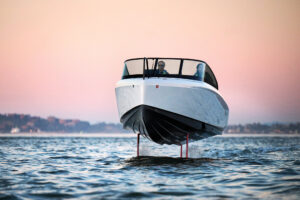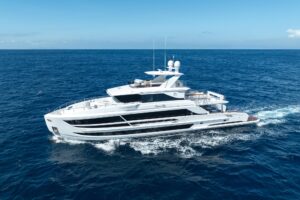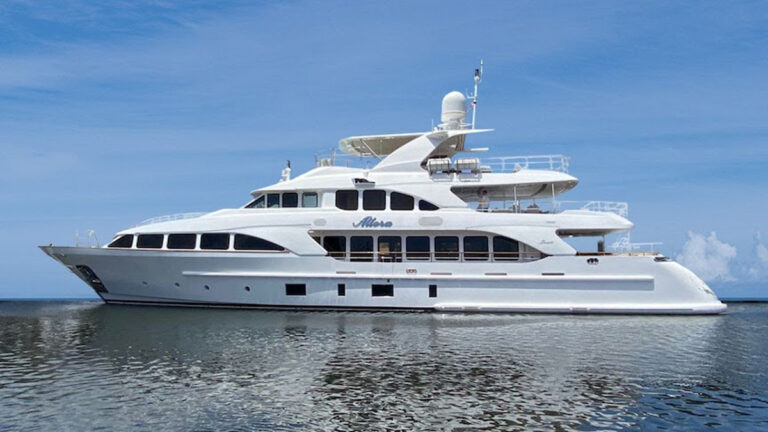Record-breaking circumnavigations, usually the exclusive domain of sailboats built as lightly and strongly as possible, took an interesting turn in 1998 when Cable & Wireless Adventurer, a Nigel Irens-designed 114-foot power trimaran, completed a voyage around the world in 74 days and 20 hours and 58 minutes, spending over 62 days at sea. Jules Verne would have been thrilled. The record was recognized by the Union Internationale Motornautique (UIM), the international sanctioning body for powerboat race records, which required Cable & Wireless Adventurer to pass through both the Panama and the Suez canals, be no longer than 150 feet, meet certain safety standards and to refuel in port, not at sea. Cable & Wireless Adventurer’s achievement was duly recorded in the logbook of adventures on the high sea. But in an age shaped by emerging technologies and barrier-busting high-tech materials, no circumnavigation record stands for long.
Earthrace, an Auckland, New Zealand-based charitable trust (www.earthrace.net) under the leadership of Aucklander Pete Bethune, is preparing to make a run at the Cable & Wireless Adventurer record with a vessel named for the planet it intends to encircle. The program includes an 18-month, pre-race tour calling at 60 of the world’s great cities, promoting fuels like biodiesel, and raising awareness about the use of sustainable resources as another approach to minimizing the impact of conventional fuels on the world’s oceans.
Designed by New Zealand naval architect Craig Loomes, Earthrace is a wavepiercing trimaran, a vessel that can glide efficiently across smooth waters or pass through the upper portions of waves when the going gets rough. To prove the concept, Bethune and Loomes built a 22-foot, scaled-down wavepiercing trimaran and fitted it out with accelerometers to measure pitch, roll and yaw. Their research showed “significant improvements in ride quality in comparison to conventional monohull design, representing a major step forward in yacht design technology,” according to Loomes.
All of the accommodations are located in the central hull, along with the head, galley, communications center and, of course, abundant tankage. Narrow forward for easy wave entrance and wider aft for efficient planing, the shape is sleek and slippery, with sponsons on either side for lateral support. Loomes has designed the trimaran’s sponsons to have enough buoyancy to sink partially into waves, offering support while minimizing rolling moment.
“The wavepiercing idea for me started when I saw a video of a VSV, which is a military troop insertion vessel,” Bethune said. “I started researching them, and stumbled onto Craig Loomes in New Zealand, who was working on a trihull wavepiercer for ferry applications. We started developing the project for setting the record for going around the globe, and tossed around single, twin and trihull concepts. In the end the trihull was the most radical, but also the most appealing from a designer’s perspective-breaking new ground.”
The original design had the living area extended out over the sponsons, Bethune said, but this caused increased drag in big waves. The next evolution was dubbed the Diablo, pictured above, a 100-footer that seemed to solve earlier resistance issues but did not fit the weight and volume criteria required to successfully set a new record. The “horns” remained on the new 78-foot, 10-ton design, now under construction, as a way to get air to the engines when the boat was partially submerged.
Differences between the record-holder and the record-seeker are worthy of note. Twin 350 hp Cummins 8.3-liter Series-C diesels drove Cable & Wireless Adventurer, a fiberglass composite structure built by England’s renowned Vosper Thornycroft, at an average speed of 16.5 knots to cover 24,500 miles. The design was predicted to have a 24-knot maximum speed and a 22-knot cruising speed. Earthrace will be powered by a pair of fuel-efficient 540 hp Cummins MerCruiser QSC8.3 diesels to a light-ship maximum speed of 40 knots and a cruising speed ranging from 15 to 25 knots.
Cummins’ QSC8.3 diesel engine (540 mhp @ 2600 rpm) is an electronically controlled diesel engine that is fully compliant with the new stringent EPA Tier 2 emissions regulations for commercial diesel engines that took effect January 2004 and proposed EPA Tier 2 levels for recreational diesel engines that take effect January 2006. In addition to being EPA Tier 2-compliant the engines will be IMO certified. They employ a new high-pressure common rail fuel system for improved fuel economy, reduced idle noise, and minimal smoke and odor. The use of the common rail fuel system has allowed the QSC to significantly reduce white smoke levels at start up without the aid of air heaters.
Expectations of a long engine life were a major objective during the development of the QSC engine, which was vital to the Earthrace planning team. Gallery-cooled alloy pistons, a high-temperature alloy cylinder head, and a strengthened block to handle higher cylinder pressures combined with high-temperature intake and exhaust valves and valve seats for reliability. The engine control module (ECM) is protected against overheating, and a water-in-fuel sensor is tied directly into the engine protection system, as is the low coolant alarm, to notify the operator of an engine coolant leak. And a more efficient after-cooler reduces intake manifold temperatures to increase power cylinder life. Stainless steel tubes are used in most of the seawater plumbing instead of hoses to help reduce maintenance.
The QSC8.3 uses MerCruiser’s SmartCraft multiplexing control and communications system to transfer information between the engine and vessel sensors to the helm using a datalink. By reducing the amount of wiring in the engineroom and at the helm (and reducing the number of terminals and wires that can corrode), reliability of the electrical system increases dramatically. The digital SmartCraft system provides instant diagnostics and operations data at the helm using inputs from numerous boat systems-fuel tank levels, GPS, steering (rudder position), water depth and temperature.
Bethune hopes that the radically shaped speedster-a composite fabrication using epoxy resins, carbon fiber/Kevlar/fiberglass on the outside, DIAB structural foams in the center, and more carbon fiber on the inside-can make passages of up to 2,500 nautical miles before refueling. Even the drive shafts and variable-pitch propellers, which were still in the design stage at the time of this writing, will be fabricated from carbon fiber, undoubtedly borrowing from the same technology used to make some helicopter prop shafts, in order to save up to 1,000 pounds in weight.
Earthrace will be fueled with biodiesel, a clean-burning alternative fuel made from renewable resources like soybeans, vegetable oils or waste animal fats. It will burn in any diesel engine without the need for costly modifications, in most cases, and will produce no environmentally harmful emissions. According to the National Biodiesel Board (www.biodiesel.org), it is 10 times less toxic than table salt and biodegrades faster than sugar-reassuring in case of a fuel spill.









